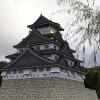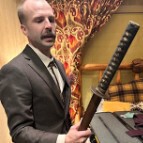-
Posts
294 -
Joined
-
Last visited
-
Days Won
3
MHC's Achievements
-
Guys, thanks for the clarifications, all crystal clear to me now. Wheww, I almost went off on an incorrect tangent, now I'm back on track, thanks to your information! Mark
-
Yes Chandler that is true, as you stated, after softening the steel, the entire blade can again be coated with clay and repeat Yakiire. Very risky however, as each repeated attempt may result in a compromised blade. The point I was referring to, was that each side of the blade cannot be hardened independently, as mentioned previously by Jean. It is done all at once, no other method is possible. Mark
-
All information regarding traditional hardening (Yakiire) of the Hamon, clearly state this process is done complete (entire blade), and only once. The clay compound is applied to the entire blade, both sides, only one time. This is a very critical step in the process, with some swords not surviving the process. These failed swords may require re-work or disposal. Additionally, sorry for my use of the word "temper", that was incorrect on my part. Still learning the correct terminology for use regarding Japanese swords. Mark
-
Hello all, First off let me state that I have really no opportunity to view swords in person, as the availability in Thailand is scarce. So I'm relegated to photos online and in books, as my information source {I know, I know not ideal to say the least}. Looking at various photos of Tantos, I often see a stark difference on the temper line detail from side to side. Several tantos I've seen pictured, barely even display any distinguishable temper line on the Omote side, while the Ura side is very clear even showing partial or entire return temper on the Mune. Is this simply a style of clay prep before tempering via individual smiths, or is this a sign of many polishes, thus removing enough metal on one side , diminishing the original detail? Second question relating to all swords, does showing core steel after a swords polish, negate it's value, or is it simply showing that the sword is on its final polish? Thank you in advance for helping out a fledgling rookie. Mark
-
Hello Alex, I wish to buy this item, but my Paypal and Venmo accounts no longer work for me now that I moved to Thailand. I will reach out to a friend in Washington state, and see if he will buy it for me. I will let you know when I find out the status. Thanks. Mark
-
Might not get much traction here, if you don't post dimensional information and better photos, including those of the Nakagao. Try using the available sales form from Brian, it is very useful. Mark
-
I can't help but feel mystified, amused and slightly pissed...all at the same time over this plodding thread and the provocateurs, be them newbies or rainy day members. Either your a member of NMB because you believe in the concepts, traditions and eloquence of Nihonto collectors/guardians, or your not. There really is no grey area here. There are a plethora of other sword forums available that will stroke DYI egos. Hell anyone can go onto Facebook/ twitter/ etc. and get all the "likes" one is clamoring for. Don't forget to take the obligatory pic's too. Can we just stop reminding everyone of the obvious and stop beating a dead horse. Is it maybe, just maybe, possible to put an end to this relentless, pointless drabble of a thread? Mark
-
Thank you all for your replies, all useful inputs. John J., your description both make complete sense, and is more consistent with what I have seen in pictures on quality, higher end blades. Sometimes I just wish swords were like classic cars, if the easy to see serial numbers match, the body, trim, paint and interior colors and options match the door tag...then bingo you have the real Macoy. Such is not the case with swords, but I guess where would be the fun in that! Mark Cannaday
-
Hello Brian, The main problem for me, is that I am only viewing blades via online photos, especially those from countries abroad, which is never ideal. Furthermore, most online photos never seem to dwell on that particular area, always at the edges of the photo or non-existent. It's so sketchy for me to try and decipher what's what with a particular blade when not in hand, compounded by my inexperience, just makes purchase decisions very difficult. I'm unfortunately very skeptical of humans in the first place, so I'm always looking for faults and problems. So when my inexperienced eye perceives something that might be out of place, my monkey brain instantly says run away. However, I don't think that is always a fair reaction, thus the question that I posed to all here. Thank you for your input. Mark Cannaday
-
Hello all, Been awhile since I have posted anything, too busy building a house. Anyway, I've been curious for quite some time now, regarding the Hamon continuing into the Nakago on an older suriage or O-Suriage blade. I would think that if a blade has been shortened more than once during it's life, and of course depending on the amount of shortening. One would think you would expect to see the original Hamon continuing into the new Nakago {in the area of the Habaki}. If a Suriage blade has 2, 3 or even 4 Mekugi-ana holes, wouldn't one not expect to at least see some blades where the Hamon continues into the Nakago {area of the Habaki}? Especially if the first Mekugi-ana hole is very near the end of the Nakago. I have seen blades with even just a partial Mekugi-and hole left on the end, surely the Hamon should present itself into the Nakago on a blade such as this. I have only seen one blade where it was clearly apparent that the original Hamon did indeed continue into the Nakago. I know that if the blade was damaged, then shortened and possibly re-tempered, you would not see this feature. However, to the well trained eye {not myself unfortunately}, other telltale features give away a re-tempered blade, so no need to comment about these. Thanks for humoring me, as I ponder this. Mark
-

katana Katana by Bizen Masamitsu with sayagaki - NBTHK
MHC replied to Seiko's topic in Swords and Edged Weapons
Hello Seiko, PM sent Mark Cannaday -
Hadori polish required for judging, yes read that on this forum and equally in several books I poses regarding polishing technics and traditions. I have a heck of a lot of books, and have read them all several times over, but alas it would take more time than I'm willing to invest in order to notate each occurrence. Especially for just a casual inquisition on the subject of this or that style of polish preference. Thanks for all of your inputs and opinions, clearly I am not alone in my preference. Mark
-
Hello all, As the title states over exaggerated Hadori polish, what do you all feel about this. I have seen swords polished well, but with a Hadori polish profile that clearly goes well beyond the actual Hamon {1 is for sale on the forum currently} I'm not a huge fan of Hadori style polish anyway, but an over exaggerated profile just instantly kills my interest in the sword. I'm aware that a Hadori style polish is the norm these days {aka required for judging}, but sure would like to see more old swords polished in the original Sashikomi style. Just one mans rambling thoughts..... Mark
-
From what I can see from the poor pictures, it appears this could(?) be a chrome plated blade. Making it a non-traditionally made blade. Additionally...yeh I would stop talking about your intent, before it gets ugly. Mark










